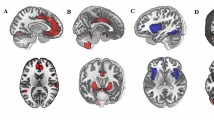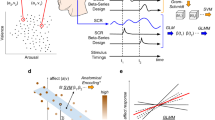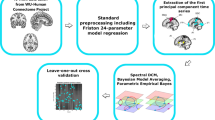Abstract
The current study used functional magnetic resonance imaging (fMRI) and showed that state anxiety modulated extrastriate cortex activity in response to emotionally-charged visual images. State anxiety and neuroimaging data from 53 individuals were subjected to an intersubject representational similarity analysis (ISRSA), wherein the geometries between neural and behavioral data were compared. This analysis identified the extrastriate cortex (fusiform gyrus and area MT) to be the sole regions whose activity patterns covaried with state anxiety. Importantly, we show that this brain-behavior association is revealed when treating state anxiety data as a multidimensional response pattern, rather than a single composite score. This suggests that ISRSA using multivariate distances may be more sensitive in identifying the shared geometries between self-report questionnaires and brain imaging data. Overall, our findings demonstrate that a transient state of anxiety may influence how visual information – especially those relevant to the valence dimension – is processed in the extrastriate cortex.


Similar content being viewed by others
Data availability
The fMRI data used to perform the analysis in the paper is available at Neurovault (https://neurovault.org/collections/16284/).
Code availability
The code and data used to perform the analysis in the paper are available on GitHub (https://github.com/CHEN-lab-NTU/state_anxiety_ISRSA).
References
Bishop, S. J. (2007). Neurocognitive mechanisms of anxiety: an integrative account. Trends in cognitive sciences, 11(7), 307–316.
Bishop, S. J., Duncan, J., & Lawrence, A. D. (2004). State anxiety modulation of the amygdala response to unattended threat-related stimuli. The Journal of Neuroscience, 24(46), 10364–10368.
Carretié, L., Fernández-Folgueiras, U., Álvarez, F., Cipriani, G. A., Tapia, M., & Kessel, D. (2022). Fast unconscious processing of emotional stimuli in early stages of the visual cortex. Cerebral Cortex, 32(19), 4331–4344.
Cataldo, A. M., & Cohen, A. L. (2015). The effect of emotional state on visual detection: A signal detection analysis. Emotion, 15(6), 846–853.
Chang, L., Jolly, E., Cheong, J. H., Burnashev, A., & Chen, P. H. A. (2018). cosanlab/nltools: 0.3.11. https://doi.org/10.5281/zenodo.2229813
Chang, L. J., Jolly, E., Cheong, J. H., Rapuano, K. M., Greenstein, N., Chen, P. H. A., & Manning, J. R. (2021). Endogenous variation in ventromedial prefrontal cortex state dynamics during naturalistic viewing reflects affective experience. Science Advances, 7(17), eabf7129.
Chen, G., Shin, Y. W., Taylor, P. A., Glen, D. R., Reynolds, R. C., Israel, R. B., & Cox, R. W. (2016). Untangling the relatedness among correlations, part I: Nonparametric approaches to inter-subject correlation analysis at the group level. NeuroImage, 142, 248–259.
Chen, P. H. A., Jolly, E., Cheong, J. H., & Chang, L. J. (2020). Intersubject representational similarity analysis reveals individual variations in affective experience when watching erotic movies. NeuroImage, 216, 116851.
Chen, P. H. A., & Qu, Y. (2021). Taking a computational cultural neuroscience approach to study parent-child similarities in diverse cultural contexts. Frontiers in Human Neuroscience, 15, 703999.
Choi, J. M., Padmala, S., & Pessoa, L. (2012). Impact of state anxiety on the interaction between threat monitoring and cognition. NeuroImage, 59(2), 1912–1923.
Cooney, R. E., Atlas, L. Y., Joormann, J., Eugène, F., & Gotlib, I. H. (2006). Amygdala activation in the processing of neutral faces in social anxiety disorder: is neutral really neutral? Psychiatry Research, 148(1), 55–59.
Davis, M., & Whalen, P. J. (2001). The amygdala: vigilance and emotion. Molecular Psychiatry, 6(1), 13–34.
de la Vega, A., Chang, L. J., Banich, M. T., Wager, T. D., & Yarkoni, T. (2016). Large-scale meta-analysis of human medial frontal cortex reveals tripartite functional organization. The Journal of Neuroscience: The Official Journal of the Society for Neuroscience, 36(24), 6553–6562.
Denny, B. T., Fan, J., Liu, X., Ochsner, K. N., Guerreri, S., Mayson, S. J., et al., (2015). Elevated amygdala activity during reappraisal anticipation predicts anxiety in avoidant personality disorder. Journal of Affective Disorders, 172, 1–7.
Etkin, A., & Wager, T. D. (2007). Functional neuroimaging of anxiety: a meta-analysis of emotional processing in PTSD, social anxiety disorder, and specific phobia. The American Journal of Psychiatry, 164(10), 1476–1488.
Finn, E. S., Glerean, E., Khojandi, A. Y., Nielson, D., Molfese, P. J., Handwerker, D. A., & Bandettini, P. A. (2020). Idiosynchrony: From shared responses to individual differences during naturalistic neuroimaging. NeuroImage, 215, 116828.
Fox, A. S., & Shackman, A. J. (2019). The central extended amygdala in fear and anxiety: Closing the gap between mechanistic and neuroimaging research. Neuroscience Letters, 693, 58–67.
Gratton, C., Laumann, T. O., Nielsen, A. N., Greene, D. J., Gordon, E. M., Gilmore, A. W., et al., (2018). Functional brain networks are dominated by stable group and individual factors, not cognitive or daily variation. Neuron, 98(2), 439-452e5.
Grupe, D. W., & Nitschke, J. B. (2013). Uncertainty and anticipation in anxiety: an integrated neurobiological and psychological perspective. Nature Reviews Neuroscience, 14(7), 488–501.
Hartley, C. A., & Phelps, E. A. (2010). Changing fear: the neurocircuitry of emotion regulation. Neuropsychopharmacology: Official Publication of the American College of Neuropsychopharmacology, 35(1), 136–146.
Hirsch, C. R., Meeten, F., Krahé, C., & Reeder, C. (2016). Resolving ambiguity in emotional disorders: The nature and role of interpretation biases. Annual Review of Clinical Psychology, 12, 281–305.
Jolly, E., & Chang, L. J. (2019). The flatland fallacy: Moving beyond low–dimensional thinking. Topics in Cognitive Science, 11(2), 433–454.
Katabi, N., Simon, H., Yakim, S., Ravreby, I., Ohad, T., & Yeshurun, Y. (2023). Deeper Than you think: Partisanship-dependent brain responses in early sensory and motor brain regions. The Journal of Neuroscience: The Official Journal of the Society for Neuroscience, 43(6), 1027–1037.
Kim, K. I., Jung, W. H., Woo, C. W., & Kim, H. (2022). Neural signatures of individual variability in context-dependent perception of ambiguous facial expression. NeuroImage, 258, 119355.
Kim, M. J., Loucks, R. A., Palmer, A. L., Brown, A. C., Solomon, K. M., Muraven, M., & Whalen, P. J. (2011). The structural and functional connectivity of the amygdala: From normal emotion to pathological anxiety. Behavioural Brain Research, 223(2), 403–410.
Kim, W., & Kim, M. J. (2022). Morphological similarity of amygdala-ventral prefrontal pathways represents trait anxiety in younger and older adults. Proceedings of the National Academy of Sciences of the United States of America, 119(42), e2205162119.
Kragel, P. A., Reddan, M. C., LaBar, K. S., & Wager, T. D. (2019). Emotion schemas are embedded in the human visual system. Science Advances, 5(7) eaaw4358.
Kriegeskorte, N., Mur, M., & Bandettini, P. (2008). Representational similarity analysis–connecting the branches of systems neuroscience. Frontiers in Systems Neuroscience, 2, 4.
Lang, P. J., Bradley, M. M., & Cuthbert, B. N. (2008). International Affective Picture System (IAPS): Instruction manual and affective ratings, Technical Report A-8. Gainesville: The Center for Research in Psychophysiology, University of Florida.
Liao, H., & Xu, Z. (2015). Approaches to manage hesitant fuzzy linguistic information based on the cosine distance and similarity measures for HFLTSs and their application in qualitative decision making. Expert Systems with Applications, 42(12), 5328–5336.
Maharani, D. A., Machbub, C., Rusmin, P. H., & Yulianti, L. (2020). Improving the capability of real-time face masked recognition using cosine distance. In 2020 6th International Conference on Interactive Digital Media (ICIDM) (pp. 1–6).
Mantel, N. (1967). The detection of disease clustering and a generalized regression approach. Cancer Research, 27(2), 209–220.
Marek, S., Tervo-Clemmens, B., Calabro, F. J. et al. (2022). Reproducible brain-wide association studies require thousands of individuals. Nature, 603, 654–660.
Mathews, A., & MacLeod, C. (1994). Cognitive approaches to emotion and emotional disorders. Annual Review of Psychology, 45, 25–50.
Mattek, A. M., Burr, D. A., Shin, J., Whicker, C. L., & Kim, M. J. (2020). Identifying the representational structure of affect using fMRI. Affective Science, 1(1), 42–56.
Mogg, K., & Marden, B. (1990). Processing of emotional information in anxious subjects. The British journal of Clinical Psychology / the British Psychological Society, 29(2), 227–229.
Morris, J. S., Friston, K. J., Büchel, C., Frith, C. D., Young, A. W., Calder, A. J., & Dolan, R. J. (1998). A neuromodulatory role for the human amygdala in processing emotional facial expressions. Brain: A Journal of Neurology, 121, 47–57.
Nguyen, M., Vanderwal, T., & Hasson, U. (2019). Shared understanding of narratives is correlated with shared neural responses. NeuroImage, 184, 161–170.
Nummenmaa, L., Glerean, E., Viinikainen, M., Jääskeläinen, I. P., Hari, R., & Sams, M. (2012). Emotions promote social interaction by synchronizing brain activity across individuals. Proceedings of the National Academy of Sciences of the United States of America, 109(24), 9599–9604.
Phelps, E. A., Ling, S., & Carrasco, M. (2006). Emotion facilitates perception and potentiates the perceptual benefits of attention. Psychological Science, 17(4), 292–299.
Rhoads, S. A., Cardinale, E. M., O’Connell, K., Palmer, A. L., VanMeter, J. W., & Marsh, A. A. (2020). Mapping neural activity patterns to contextualized fearful facial expressions onto callous-unemotional (CU) traits: intersubject representational similarity analysis reveals less variation among high-CU adolescents. Personality Neuroscience, 3, e12.
Riemann, B. C., & McNally, R. J. (1995). Cognitive processing of personally relevant information. Cognition and Emotion, 9(4), 325–340.
Somerville, L. H., Kim, H., Johnstone, T., Alexander, A. L., & Whalen, P. J. (2004). Human amygdala responses during presentation of happy and neutral faces: correlations with state anxiety. Biological Psychiatry, 55(9), 897–903.
Spielberger, C. D., Gorsuch, R. L., Lushene, R., Vagg, P. R., & Jacobs, G. A. (1983). Manual for the State-Trait Anxiety Inventory. Palo Alto, CA: Consulting Psychologists Press.
Spisak, T., Bingel, U., & Wager, T. D. (2023). Multivariate BWAS can be replicable with moderate sample sizes. Nature, 615, E4–E7.
van Baar, J. M., Chang, L. J., & Sanfey, A. G. (2019). The computational and neural substrates of moral strategies in social decision-making. Nature Communications, 10(1), 1483.
Vuilleumier, P., & Pourtois, G. (2007). Distributed and interactive brain mechanisms during emotion face perception: evidence from functional neuroimaging. Neuropsychologia, 45(1), 174–194.
Wagner, D. D., & Heatherton, T. F. (2012). Self-regulatory depletion increases emotional reactivity in the amygdala. Social Cognitive and Affective Neuroscience, 8, 410–417.
Xu, Q., Hu, J., Qin, Y., Li, G., Zhang, X., & Li, P. (2023). Intention affects fairness processing: Evidence from behavior and representational similarity analysis of event-related potential signals. Human Brain Mapping, 44(6), 2451–2464.
Yoon, K. L., & Zinbarg, R. E. (2008). Interpreting neutral faces as threatening is a default mode for socially anxious individuals. Journal of Abnormal Psychology, 117(3), 680–685.
Acknowledgments
This research was supported by funding from the NSTC and MOE (MOST 109-2636-H-002-006 and 110-2636-H-002-004; NSTC 111-2628-H-002-004 and 111-2423-H-002-008-MY4; MOE NTU-CC-110L9A00702 and 112L9A00402 to P.-H.A. Chen) in Taiwan. This research was also supported by the National Research Foundation of Korea (NRF-2021R1F1A1045988 to M.J. Kim).
Declarations
Funding
This research was supported by funding from the NSTC and MOE (MOST 109-2636-H-002-006 and 110-2636-H-002-004; NSTC 111-2628-H-002-004 and 111-2423-H-002-008-MY4; MOE NTU-CC-110L9A00702 and 112L9A00402 to P.-H.A. Chen) in Taiwan. This research was also supported by the National Research Foundation of Korea (NRF-2021R1F1A1045988 to M.J. Kim).
Author information
Authors and Affiliations
Contributions
Study design (Chen, P.-H. A.), data collection (Chen, P.-H. A.), statistical analysis (Hsiao, P.-Y. A. and Chou, F.-C. B.), interpretation of results (Hsiao, P.-Y. A, Kim, M.J. and Chen, P.-H. A.), writing the manuscript (All authors), and approval of final version to be published and agreement to be accountable for the integrity and accuracy of all aspects of the work (All authors).
Corresponding author
Ethics declarations
Ethics approval
This research conformed to all guidelines of the institutional review board at Dartmouth College.
Consent to participate
Informed consent was obtained from each participant.
Consent for publication
All co-authors have seen and agreed with the contents of the manuscript. We certify that this submission is an original work and is not under review at any other publication.
Competing interests
The authors declare no competing interests.
Conflicts of interest
All co-authors have no competing interests to declare.
Additional information
Publisher’s Note
Springer Nature remains neutral with regard to jurisdictional claims in published maps and institutional affiliations.
Supplementary Information
Below is the link to the electronic supplementary material.
ESM 1
(DOCX 466 KB)
Rights and permissions
Springer Nature or its licensor (e.g. a society or other partner) holds exclusive rights to this article under a publishing agreement with the author(s) or other rightsholder(s); author self-archiving of the accepted manuscript version of this article is solely governed by the terms of such publishing agreement and applicable law.
About this article
Cite this article
Hsiao, PY.A., Kim, M.J., Chou, FC.B. et al. Intersubject representational similarity analysis uncovers the impact of state anxiety on brain activation patterns in the human extrastriate cortex. Brain Imaging and Behavior 18, 1–9 (2024). https://doi.org/10.1007/s11682-024-00854-1
Accepted:
Published:
Issue Date:
DOI: https://doi.org/10.1007/s11682-024-00854-1




